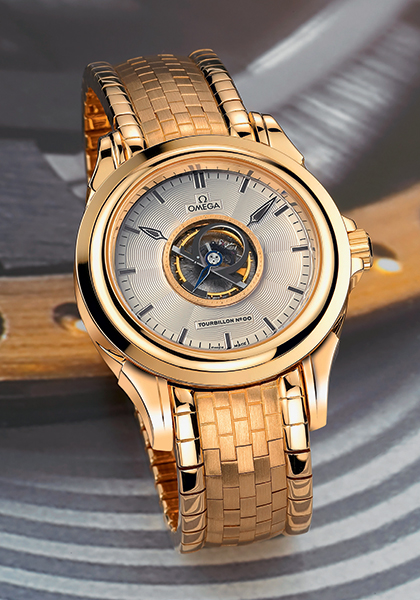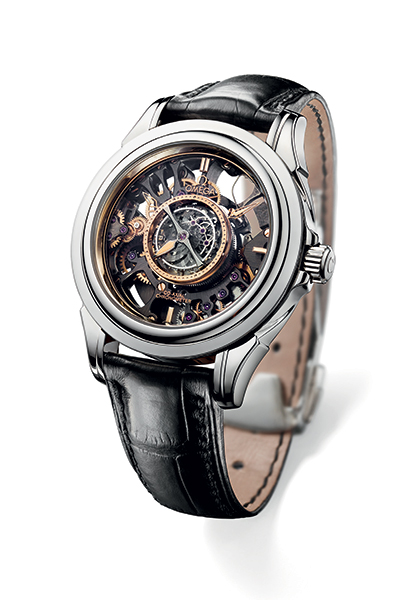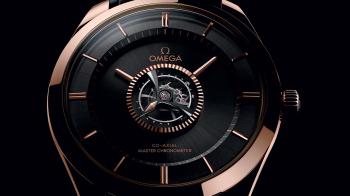In 1994, at a time when tourbillons were gradually coming back into fashion, Omega unveiled a model located right in the middle of the dial. This pioneering timepiece bursting with creativity is one of the most spectacular tourbillons ever.
Where should a tourbillon go? The question has been the subject of passionate debate among watchmakers. Purists usually say it should be on the movement side, arguing that the tourbillon is merely another addition to the different kinds of regulating organ, so its rightful place is not on the dial side. Thus says the most orthodox (if not legalistic) doctrine, followed by Patek Philippe, Laurent Ferrier and others.

However, the trend over the past 20 years has been to have the tourbillon on the dial side, due to the entertainment value it adds to the timepiece and its highly technical features that are so appealing to collectors. For those taking that road, the tourbillon has naturally found a home at the 6 o’clock spot.
Why so? The explanation is technical first and foremost, at least as far as traditionally- designed movements go. The tourbillon cannot be located at 3 o’clock, because that’s where the winding stem is. It can’t be at 12 o’clock, because that’s where the barrel goes. That leaves a segment between 6 and 9 o’clock. For reasons of aesthetic balance, most firms choose to place their name at 12 o’clock, with the tourbillon as a sort of counterpoint at 6 o’clock.
Three times a winner Potentially, the tourbillon can therefore be positioned anywhere other than in the same location as the barrel or the winding stem. Omega was to offer a whole new take on that premise. In 1994, the brand unveiled its 5910.30 Tourbillon, powered by the 1170 calibre. The difference is immediately apparent: the tourbillon is located in the centre, a most ingenious idea.
Firstly, there’s the resulting visual impact. The tourbillon asserts itself with its inescapable, technical, hypnotic presence. Omega further reinforced its impact by designing a large cage echoing its logo, the Greek letter omega. Also of note is the presence of an unusually large quantity of flyweights around the rim to provide equilibrium for the balance wheel, inevitably creating quite an effect. Another aesthetic detail is that the brand has used ‘mysterious hours’, with the hours and minutes hands operated by invisible sapphire discs. And by placing its tourbillon in the middle, Omega has exploited the natural curvature of the sapphire crystal, beneath which the tourbillon fits quite naturally, without needing to increase the thickness of the case.

The location is also a very smart one in technical terms. In placing its tourbillon in the centre, Omega has adopted a very vertical construction. The tourbillon literally sits atop the movement, making plenty of room available on the lower level. At the same time, to avoid the watch being too thick for its diameter (just 38mm), Omega opted for a bâti-fond construction. This method, popularised by the Swatch watch, consists in using the caseback itself as the baseplate supporting certain movement components. Developed by watchmaker Maurice Grimm and engineer André Beyner, the technique resulted in the slimmest quartz watch in the world (2mm including the case). And finally, it’s worth noting that the model’s platinum oscillating weight is off-centre, a rare occurrence in watchmaking that further contributes to the eminently singular nature of the movement, constructed solely for this specific central tourbillon model.
A prestigious legacy The central tourbillon gradually became established as a hallmark of Omega (as well as of independent watchmaker Beat Haldimann). It would be the best part of ten years before the brand unveiled another new variation in 2002, the Tourbillon Central 5113.30.00 (2600B calibre) with COSC certification. The base movement was in fact the same as the 1994 version, testifying to its extreme reliability and accuracy. A skeleton version was to follow in 2010, the Omega Co-Axial 2636 calibre, also COSC certified.
In 2020, a new variation appeared, distinguished by the fact that it is a manual-winding movement, whereas the previous versions were self-winding – a deliberate hat tip to the first tourbillon wristwatch ever made by Omega, back in 1947. That said, the 2020 tribute timepiece also begins a new chapter in the history of time-keeping: in addition to being COSC certified, as in 2002, this central tourbillon is the first in the history of the Manufacture to receive Master Chronometer certification.
*This year GMT Magazine and WorldTempus have embarked on the ambitious project of summarising the last 20 years of the Tourbillon in The Millennium Watch Book - Tourbillons, a big, beautifully laid out coffee table book. This article is an extract. The Millennium Watch Book - Tourbillons is available on www.the-watch-book.com, in French and English.





